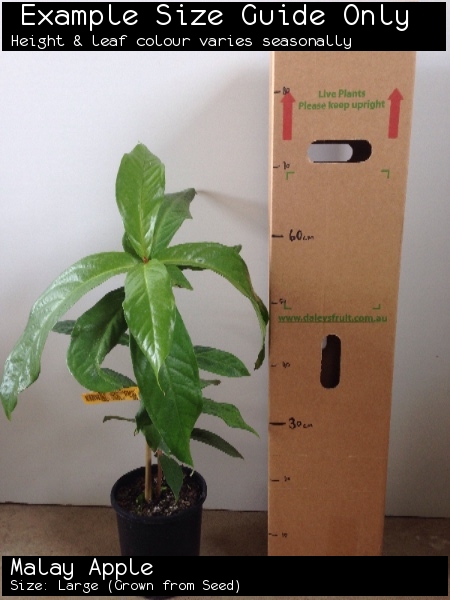Malay Apple
Syzygium malaccense$23.90 ($23.90-$39.00 choose a size)
Specifications of Malay Apple
Preferred Climate Tropical, SubtropicalLearn About Climate Zones
Grown From SeedlingLearn About Propagation Methods
Max Height (when in the ground with good conditions) +10m
Plants required to Pollinate 1 (Self Pollinating)Learn about Pollination
Can it Handle Frosts? Likes Temps above 5deg
Amount of leaves in Winter? All Leaves (Evergreen)
Quarantine Restrictions to these Areas SA, WA
Water Requirements Moderate Watering
Is it a Dwarf Fruit Tree? No (Full Size)
Time to Fruit/Flower/Harvest 5+ Years
Sun or Shade Full (Sun:80%-100%)
Preferred Soil Type Good Drainage
Soil pH Neutral (6.6-7.3pH)
Fruiting/Harvest Months March, April, May
Create a Filter to find similar plants
Customers also bought
These plants are often purchased together. Also check plant information for suitability in your orchard.
Achacha - Grafted
$99.00
Wax Jambu - Red
$79.00 ($34.00-$99.00 choose a size)
Brazilian Cherry - Black Beauty
$49.00 ($49.00-$79.00 choose a size)
Star Gooseberry
$29.00 ($19.75-$29.00 choose a size)
Nam Nam
$49.00
Guiana Chestnut
$29.00 ($29.00-$49.00 choose a size)
Customer Tips & Reviews Malay Apple
Sydney, NSW
Malay Apple
Easy to eat and can be used as a salad but must remove core-look out for worms.Can be eaten with sweet chili and soy sauce to remove aftertaste


























